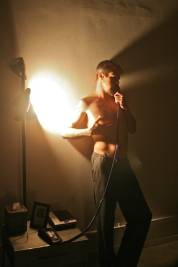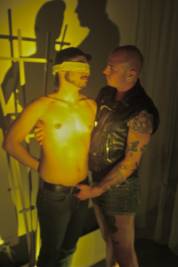NOT RECOMMENDED
Robert Chesley’s 1986 two-character drama Jerker has been called “one of the most important pieces of gay theater ever created,” though you’d be hard-pressed to determine why this is so based only on the 25th Anniversary production now on stage at Space 916 in West Hollywood.
Jerker’s complete title (Jerker, or The Helping Hand: A Pornographic Elegy with Redeeming Social Value and a Hymn to the Queer Men of San Francisco in Twenty Telephone Calls, Many of Them Dirty) proves an apt synopsis of the play as it was written two and a half decades ago. A pair of 30-40something gay men living in AIDS-ravaged San Francisco become acquainted via a series of phone calls, a good many of which have the sole purpose of getting the two men’s rocks off long distance and in separate beds, the ongoing epidemic offering them no safer sex option. Over the course of these phone sex calls, a relationship develops between them, one that eventually dares to speak its name.
Chesley’s characters are unapologetic about the promiscuous, unprotected sex they sought out on a nightly basis in those heady post-Stonewall, pre-AIDS days. They even go so far as to celebrate its very raunchiness (and this includes piss and pain and the liberal exchange of bodily fluids) as the purest expression of love, and whether or not you agree with them, it is undeniable that Bert and J.R. do make a connection that is deep and real and profoundly human.
Jerker is a play whose power lies in its very simplicity. There are two actors. There is a stage. There are words. Find the right performers and Jerker could jerk tears and move hearts even performed à la Love Letters, scripts in hand and without a single set piece or prop in sight. Hire a topnotch team of set, lighting, and sound designers and you’d have a production of guaranteed power and impact.
Director Glenn Kessler makes the egregious mistake of thinking that Chesley’s play needs to be improved upon, or that 21st Century audiences won’t sit still for ninety minutes of talk, no matter how brilliantly performed.
The result is a production which finds it necessary to “illustrate” most of Bert and J.R.’s phone sex chats by adding a troupe of five well-built, scantily clad actors of varying types performing explicit reenactments of the spoken sex scenes. How explicit are these pantomimes? In one scene, one actor squeezes another’s semi-erect penis and ties it up with a ripped piece of underwear. In another, one naked actor lies atop another, genitals against buttocks.
Now far be it from this reviewer to complain about nudity or even simulated sex onstage. It’s a box office draw that has drawn me into many a production, and will I’m sure again.
However, to insert explicit sex scenes into Jerker is nothing less than a perversion of the author’s intent, though sadly we cannot query him on the matter, the playwright having succumbed to AIDS in 1990 at the age of 47.
Chesley understood that phone sex is about the power of the imagination. Kessler seems to think that we need live visual aids. Making matters worse is that seeing Bert and J.R.’s sex talks brought to life actually distracts us from Chesley’s words and from determining for ourselves whether or not Jerker is the classic it’s cracked up to be. Even the devastating simplicity of the play’s final moments is marred by yet another intrusion of the ubiquitous ensemble.
Not that this production makes it particularly easy to become involved in the mostly prerecorded performances of Gregory Allen as Bert and director Kessler as J.R. That’s right. For at least the first hour or so of the show, the two actors lip-sync their lines to a prerecorded soundtrack, their mouths deliberately blocked from view by the receivers, though the last half hour is mostly live, go figure.
Needless to say, it’s difficult to evaluate Allen’s and Kessler’s performances, though each does seem at the very least committed to doing serious work.
Corey Adam Affron, Gregory Barnett, Ben Cuevas, Parnell Damone, and Sammy Murrian make up the equally committed ensemble, though it is curious that in the one scene in which the text calls explicitly for nudity from the youngest two of them, the duo are conspicuously garbed in matching black jock straps, leading one to wonder if certain ensemble members’ committment had limits that others’ did not. Damone deserves applause for his gorgeous vocals.
Chesley’s staging further hampers our involvement by placing the two beds so far apart on the wide stage area that anyone seated far left or right sees one of the performances from a considerable distance throughout, and while having the two men face each other rather than the audience does allow the aforementioned mouth-blocking, Jerker would be far more effective if Bert and J.R. were looking in our direction and we could actually see their faces.
Michael Jackson deserves kudos for his effective lighting design. On the other hand, it’s hard to know what to say about Purple Crush’s sound design since hearing the actors’ recorded voices coming from somewhere center stage makes it often difficult to distinguish who’s talking and who’s listening. In the sound designers’ favor, there is an effective use of music. Majd Murad receives credit for mask design. This 25th Anniversary Production of Jerker is presented by Jason Moyer. There is no credited stage manager.
It’s always disappointing to see the hard work and dedication of a group of theater artists not yield the kind of results they are striving for. In the case of Jerker, it’s close to tragic.
Space 916, 916 Formosa Avenue, Hollywood.
www.jerker25.com
–Steven Stanley
November 13, 2011
Photos: Jason Moyer





 Since 2007, Steven Stanley's StageSceneLA.com has spotlighted the best in Southern California theater via reviews, interviews, and its annual StageSceneLA Scenies.
Since 2007, Steven Stanley's StageSceneLA.com has spotlighted the best in Southern California theater via reviews, interviews, and its annual StageSceneLA Scenies.







 COPYRIGHT 2024 STEVEN STANLEY :: DESIGN BY
COPYRIGHT 2024 STEVEN STANLEY :: DESIGN BY